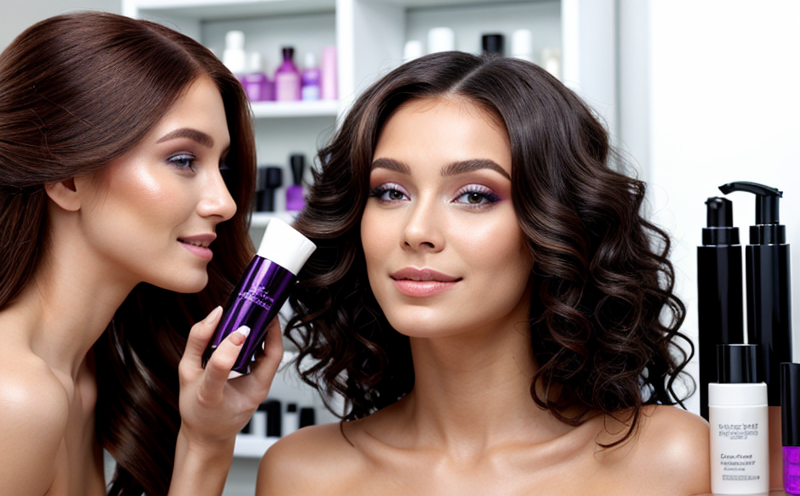Rheological Testing of Hair Gels
The rheological testing of hair gels is a critical procedure in the cosmetics industry. This test assesses the physical properties and behavior of hair gel formulations under various shear rates and viscosities, which are essential for ensuring product performance, stability, and user satisfaction.
Rheology plays an important role in determining the spreadability, emulsification strength, and overall quality of hair gels. Understanding these parameters is crucial during formulation development and production to ensure that the final product meets both regulatory standards and consumer expectations.
During rheological testing, samples are subjected to a controlled shear rate or stress using specialized equipment like rotational viscometers or cone-plate viscometers. The data collected includes modulus values (elastic and viscous), yield point, and thixotropy behavior. These parameters help in optimizing the formulation for improved texture and performance.
The testing process involves precise sample preparation to ensure accurate results. Samples are typically prepared by dissolving or mixing the hair gel with a solvent if necessary, ensuring homogeneity throughout. The samples are then placed into appropriate containers suitable for rheological analysis. This step is crucial as it ensures that the test conditions mimic real-world application scenarios.
The equipment used in rheological testing includes rotational viscometers equipped with various accessories such as cone and plate geometry, parallel plates, or spindles. The selection of these depends on the specific requirements of the sample being tested. For hair gels, a cone-plate configuration is often preferred due to its ability to simulate shear conditions encountered during application.
Once prepared, the samples are subjected to controlled shear stress and/or strain rates. This allows for the measurement of both elastic and viscous components of deformation. The data collected can reveal important information about the gel's consistency, elasticity, and fluidity, which are critical factors in determining how well the product will perform during use.
The rheological properties determined by this test are also vital for ensuring compliance with relevant standards such as ISO 28140:2017. These standards provide guidelines on how to conduct rheological measurements accurately and consistently across different laboratories, thereby enhancing reliability in quality control processes.
Scope and Methodology
| Aspect | Description |
|---|---|
| Sample Preparation | Samples are prepared by dissolving or mixing the hair gel with a solvent if necessary, ensuring homogeneity throughout. |
| Test Equipment | Rotational viscometers equipped with various accessories such as cone and plate geometry, parallel plates, or spindles. |
| Shear Rate/Strain Rate Control | The samples are subjected to controlled shear stress and/or strain rates to measure both elastic and viscous components of deformation. |
| Data Collection | Modulus values (elastic and viscous), yield point, thixotropy behavior, spreadability, emulsification strength. |
The scope of rheological testing encompasses the evaluation of various physical properties of hair gels. These include modulus values which indicate how much a material will deform under stress before returning to its original shape; yield point signifies the minimum amount of shear stress required to produce permanent flow or deformation in the sample; and thixotropy behavior describes the change in viscosity with applied force.
Spreadability is another key aspect measured during this test. It refers to how easily a hair gel can be spread over the scalp, which significantly impacts user experience. Emulsification strength measures the stability of emulsions within the hair gel formulation, ensuring that all ingredients remain properly mixed and do not separate.
Industry Applications
- Evaluation of spreadability during application.
- Determination of emulsification strength for maintaining ingredient stability.
- Prediction of product performance under various conditions.
- Optimization of formulation parameters to enhance consumer satisfaction.
- Ensuring compliance with international standards like ISO 28140:2017.
Rheological testing finds extensive application in the cosmetics sector, particularly for hair care products. By providing detailed insights into the physical properties of these gels, it aids manufacturers in optimizing their formulations to meet both regulatory requirements and market demands.
For instance, rheology can help identify the optimal ratio of active ingredients versus carriers that will yield the desired texture and performance. Additionally, this testing ensures that products are stable over time without separating or losing effectiveness during storage and use.
Why Choose This Test?
The rheological testing of hair gels offers several advantages over other types of cosmetic analysis. Firstly, it provides a comprehensive view of the physical properties that directly influence consumer experience and product performance. Secondly, this test is instrumental in ensuring compliance with international standards such as ISO 28140:2017.
By conducting rheological tests early in the development process, companies can make informed decisions regarding ingredient selection, formulation adjustments, and processing conditions. This proactive approach not only enhances product quality but also minimizes costly rework later on in production cycles.
In conclusion, choosing rheological testing for hair gels is essential for any company committed to delivering high-quality cosmetic products that meet stringent regulatory requirements while exceeding customer expectations. The detailed insights provided by this testing method enable manufacturers to innovate effectively and stay ahead of competitors in the rapidly evolving cosmetics market.





